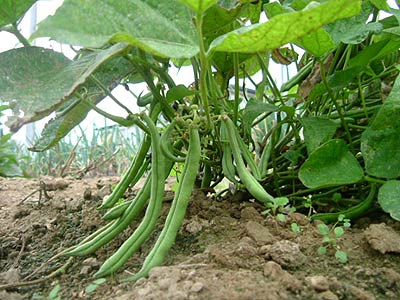 Well, all the plants are in the ground in our food bank garden.
Well, all the plants are in the ground in our food bank garden.It was pretty fun listening to all the real horticulturalists hash out the details to our plan, with frequent reference to the classic Knott's Handbook, which is definitely now on my wishlist. Those guys really know production ag - especially through their professional and familial ties to our local upstate farmers.
So here's our acre: It was winter cover-cropped in rye, the farm crew tilled it in, built up beds and lay plastic mulch (picture 2 x 200' strips of black plastic garbage bags) over granular fertilizer. We decided to take our chances and skip the irrigation tape. The whole thing was split into four blocks - each containing the appropriate number and width of rows to allow a tractor with 20' booms to reach everything. Each block needed to be limited to one crop family in case we need to spray pesticides later (which are regulated by crop family).
Block one
Green beans, mechanically seeded and harvested. We couldn't possibly harvest by hand what will literally be a TON of green beans - and we couldn't plant by hand and get straight enough rows for the tractor to harvest it (do you think you could plant a 200' line perfectly straight?). I can't wait to see what a ton of green beans looks like...
Block two
We planted tomato (and a few pepper) transplants with a water wheel into plastic mulch on a raised bed. The water wheel in this video actually looks pretty much the exact same as ours. No bell peppers though, modern varieties have such heavy yields that they would need to have a trellis woven around them during the season to keep their stems from snapping - and wouldn't mature past the green stage in our climate anyway.
Block three
Same with our Brassicas (water wheel into plastic mulch). We planted a bunch of good-storing cabbages along with some broccoli, Napa cabbage and locally-bred orange and purple cauliflower. We were told that Upstate NY farmers would laugh at us for using plastic mulch for these plants, but we didn't have time to weed the plot regularly. Normally these might be direct-seeded earlier in the season, but we were running late and needed to put out strong transplants or else the early summer flea beetles would obliterate them.
Block four
Same again with our curcurbits (mostly good-storing winter squash along with some locally-bred cantaloupe). Summer squash was not considered - we'd have to pick it every two days!
Someone at the spring meeting had suggested putting in another crop after we harvest the beans, but one of the hort guys said any farmer in his right mind would happily declare the block fallow for the year and be done with it, unless, he joked, he was in California where he'd rip it all up and have it in strawberries the next day!
I have to say, I could definitely get used to buying seed by the pound...

No comments:
Post a Comment